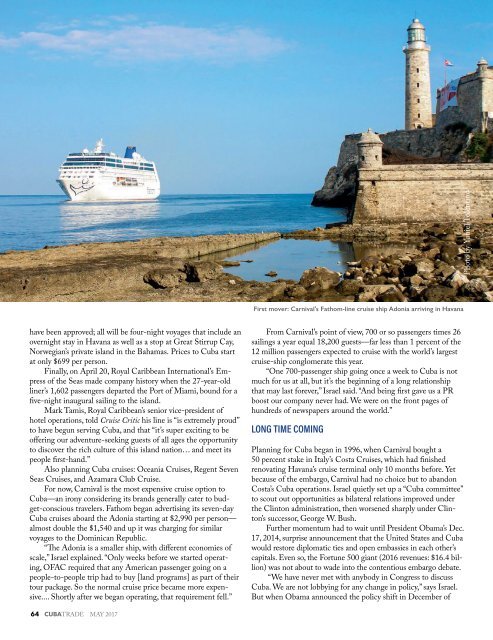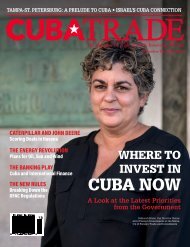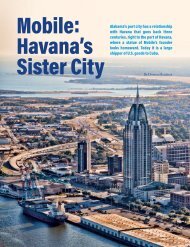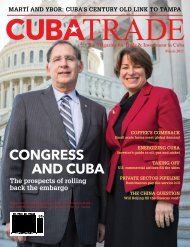CubaTrade-May2017-Flipbook
Create successful ePaper yourself
Turn your PDF publications into a flip-book with our unique Google optimized e-Paper software.
have been approved; all will be four-night voyages that include an<br />
overnight stay in Havana as well as a stop at Great Stirrup Cay,<br />
Norwegian’s private island in the Bahamas. Prices to Cuba start<br />
at only $699 per person.<br />
Finally, on April 20, Royal Caribbean International’s Empress<br />
of the Seas made company history when the 27-year-old<br />
liner’s 1,602 passengers departed the Port of Miami, bound for a<br />
five-night inaugural sailing to the island.<br />
Mark Tamis, Royal Caribbean’s senior vice-president of<br />
hotel operations, told Cruise Critic his line is “is extremely proud”<br />
to have begun serving Cuba, and that “it’s super exciting to be<br />
offering our adventure-seeking guests of all ages the opportunity<br />
to discover the rich culture of this island nation… and meet its<br />
people first-hand.”<br />
Also planning Cuba cruises: Oceania Cruises, Regent Seven<br />
Seas Cruises, and Azamara Club Cruise.<br />
For now, Carnival is the most expensive cruise option to<br />
Cuba—an irony considering its brands generally cater to budget-conscious<br />
travelers. Fathom began advertising its seven-day<br />
Cuba cruises aboard the Adonia starting at $2,990 per person—<br />
almost double the $1,540 and up it was charging for similar<br />
voyages to the Dominican Republic.<br />
“The Adonia is a smaller ship, with different economies of<br />
scale,” Israel explained. “Only weeks before we started operating,<br />
OFAC required that any American passenger going on a<br />
people-to-people trip had to buy [land programs] as part of their<br />
tour package. So the normal cruise price became more expensive....<br />
Shortly after we began operating, that requirement fell.”<br />
First mover: Carnival's Fathom-line cruise ship Adonia arriving in Havana<br />
From Carnival’s point of view, 700 or so passengers times 26<br />
sailings a year equal 18,200 guests—far less than 1 percent of the<br />
12 million passengers expected to cruise with the world’s largest<br />
cruise-ship conglomerate this year.<br />
“One 700-passenger ship going once a week to Cuba is not<br />
much for us at all, but it’s the beginning of a long relationship<br />
that may last forever,” Israel said. “And being first gave us a PR<br />
boost our company never had. We were on the front pages of<br />
hundreds of newspapers around the world.”<br />
LONG TIME COMING<br />
Planning for Cuba began in 1996, when Carnival bought a<br />
50 percent stake in Italy’s Costa Cruises, which had finished<br />
renovating Havana’s cruise terminal only 10 months before. Yet<br />
because of the embargo, Carnival had no choice but to abandon<br />
Costa’s Cuba operations. Israel quietly set up a “Cuba committee”<br />
to scout out opportunities as bilateral relations improved under<br />
the Clinton administration, then worsened sharply under Clinton’s<br />
successor, George W. Bush.<br />
Further momentum had to wait until President Obama’s Dec.<br />
17, 2014, surprise announcement that the United States and Cuba<br />
would restore diplomatic ties and open embassies in each other’s<br />
capitals. Even so, the Fortune 500 giant (2016 revenues: $16.4 billion)<br />
was not about to wade into the contentious embargo debate.<br />
“We have never met with anybody in Congress to discuss<br />
Cuba. We are not lobbying for any change in policy,” says Israel.<br />
But when Obama announced the policy shift in December of<br />
Photo by Yaniel Tolentino<br />
2014, he says, “We were ready.” Once regulations were issued in<br />
January 2015, Carnival immediately applied for a permit to offer<br />
Cuba cruises from the U.S. Treasury Department’s Office of Foreign<br />
Assets Control (OFAC), which enforces the embargo. That<br />
process took about three months from beginning to end.<br />
Next on the agenda was applying to the Cuban government<br />
for permission to bring cruise ships to the island—a concept Fidel<br />
Castro had always opposed. In a 2005 speech, he famously complained<br />
that these “floating diversions visit countries to leave their<br />
trash, their empty cans and papers, for a few miserable cents.”<br />
Fidel is now gone, and his brother Raúl has said little publicly<br />
about the cruise-ship industry. Just to be safe, said Israel, “it<br />
very quickly dawned on us that maybe a combination of a smaller<br />
ship and socially responsible cruising would be a good match.<br />
We knew Cuba didn’t get a lot of cruise-ship passengers and that<br />
they were concerned about big ships. We thought this would be<br />
the smartest thing to do, and in retrospect, I can tell you we did<br />
absolutely the right thing.”<br />
Israel said Carnival began promoting its Fathom cruises<br />
even before the required Cuban government approvals, with<br />
the understanding that full refunds would be given in the event<br />
those approvals failed to materialize. In the end, that wasn’t<br />
necessary. Cuba signed off on the cruises, and on March 20, 2016,<br />
Obama—in the first visit to Havana by any sitting president in<br />
88 years—declared that Carnival would begin cruising to Cuba<br />
shortly; he also announced that memos of understanding had<br />
been reached with Starwood Hotels and General Electric.<br />
“After he finished his speech, we were asked to come on<br />
stage,” recalled Israel, who met Obama that day. “We were the<br />
only ones to sign an actual agreement, and we issued a press<br />
release minutes later.”<br />
As thrilling as that moment was, it didn’t compare to the<br />
Adonia’s arrival in Cuba on May 2, the day after the gleaming<br />
white vessel departed the Port of Miami. “I had been in Havana<br />
a dozen times, but the arrival of the first U.S. cruise ship after 54<br />
years was an extraordinary lifetime experience,” Israel said.<br />
THE IMPACT<br />
How much cruising actually means for Cuba in dollar terms<br />
is debatable. If all the cruise lines that have expressed interest<br />
actually go through with their plans, the island could earn about<br />
$80 million a year, according to the US-Cuba Trade and Economic<br />
Council. John Kavulich, who runs the council, estimated<br />
that the cruise companies pay the Cuban government an average<br />
$500,000 per cruise, in addition to per-passenger expenditures.<br />
According to the Florida Caribbean Cruise Association,<br />
the average expenditure by a cruise passenger visiting a Carribbean<br />
port is around $100; during the 2014-15 cruise season, the<br />
average per passenger was $103.83.<br />
Cuba may prove to be an exception, however. FCCA<br />
President Michele L. Paige disputes the notion that U.S. cruise<br />
passengers will crowd the streets of Havana by the thousands<br />
without contributing anything to the Cuban economy. “Cruise<br />
passengers and crew [to Cuba] spend more than any other<br />
[cruise] tourist because they’re consuming, not relaxing. They’re<br />
on an educational quest,” she said. “Under U.S. law, they have to<br />
have a people-to-people educational experience.”<br />
But noted Cuba travel expert Christopher Baker said he’s<br />
“dismayed”—to put it politely—with the multitude of Americans<br />
descending upon Havana in recent months. “The sheer volume<br />
of passengers now roaming the colonial plazas of Habana Vieja<br />
has diluted the ‘authentic’ Cuban experience,” Baker complained.<br />
“Until now, the land-based, people-to-people programs that have<br />
been the mainstay of U.S. visitation has drawn principally from a<br />
high-income and highly educated demographic. These have proven<br />
to be travelers who desire a deep cultural immersion in Cuba.”<br />
By contrast, he said, “Carnival’s clientele is down-market and will<br />
undoubtedly cheapen Cuba’s image.”<br />
The situation has changed so radically, he claims, that entities<br />
such as National Geographic Expeditions—which has run P2P<br />
programs in Cuba for the past six years—is now looking for new<br />
venues, “as the cruise-ship throngs are being bussed en masse to<br />
artists’ studios and other places that previously offered a uniquely<br />
Cuban experience.”<br />
For now, Cuba's port infrastructure does not<br />
allow our ships to go to other ports. Obviously,<br />
once infrastructure improvements are made,<br />
ships will call on other ports.<br />
Giora Israel, Carnival's senior vice president<br />
of global port and destination development<br />
Israel, of course, sees things differently. Cuba, he says, is still a<br />
relative virgin compared to far more accessible cruise-ship destinations<br />
such as Cozumel, Mexico; St. Thomas, U.S. Virgin Islands;<br />
and Montego Bay, Jamaica.<br />
The Adonia’s last sailing from Miami will be May 28,<br />
which also coincides with the end of the Fathom brand itself.<br />
It will be replaced in June with the 2,000-passenger Carnival<br />
Paradise, which will begin Cuba voyages from its base in Tampa.<br />
Eight four-day sailings to Cuba are scheduled, as are four<br />
five-day sailings that include a stop in Cozumel or Key West.<br />
The 10-deck Paradise, at 262 meters long and with a draft of<br />
7.8 meters, is the largest-size ship that can currently berth in<br />
Havana; the other ports in Cuba cannot accommodate a ship<br />
its size.<br />
“For now, Cuba’s port infrastructure does not allow our<br />
ships to go to other ports. Obviously, once infrastructure improvements<br />
are made, ships will call on these other ports,” Israel<br />
explained.<br />
Israel added that Carnival has identified “probably eight or<br />
nine ports on the north and south coasts of Cuba that would<br />
be appealing and interesting. We’re looking at all of them.” He<br />
declined to elaborate further, except to say that more cruise announcements<br />
are upcoming. H<br />
64 CUBATRADE MAY 2017<br />
MAY 2017 CUBATRADE<br />
65
















